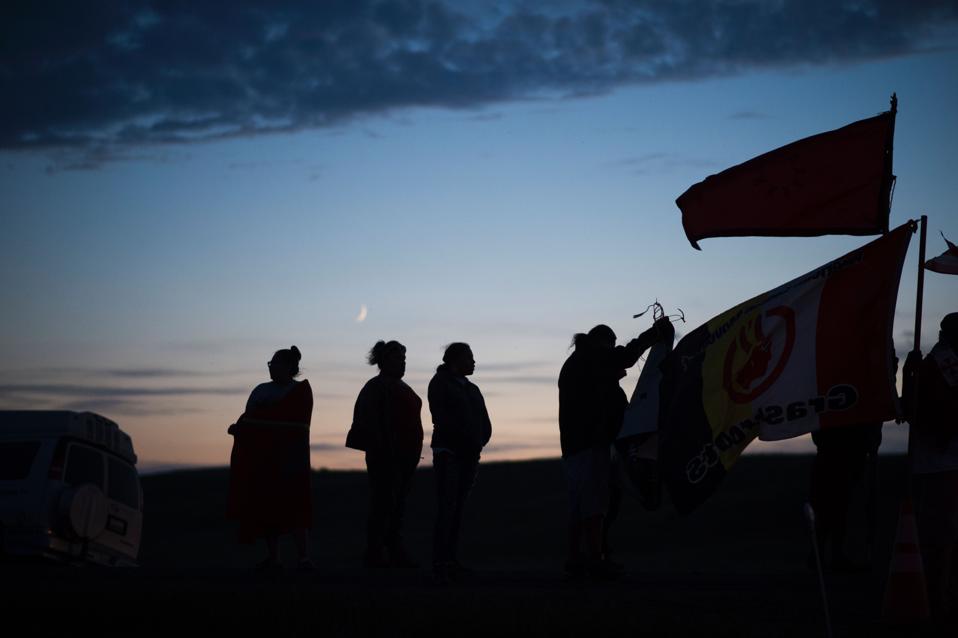Except for the last remaining climate change deniers, of which there are still a surprising number, it is generally acknowledged that many of the oil reserves that have already been discovered are “stranded assets.” This means that in order to ensure that global warming does not rise to 2C above pre-industrial levels, the target agreed to in the COP21 Paris Agreement which went into effect on November 4, 2016, these reserves cannot be extracted.
The U.K. nonprofit Carbon Tracker calculates that only 565 gigatons of CO2 from the world’s coal mines, oil wells, and gas fields can be emitted between now and 2050 in order to meet the COP21 benchmark. This is only 20% of the 2,795 gigatons of CO2 in existing reserves. While the market value of these stranded assets is obviously a function of price, in the days following COP21 analysts at Citigroup estimated the potential value of stranded assets at $100 trillion. However much oil ends up being taken out of the ground, much of it will go through pipelines. A corollary of stranded assets is that, in addition to oil reserves, some amount of pipeline capacity will become stranded assets as well.
$647 billion was invested in drilling last year, a figure that is in the same region as the $1 trillion that needs to be invested per year in clean energy between now and 2030. And just as oil and gas companies continue to drill, pipeline companies continue to build. A dramatic and contentious recent example is Energy Transfer Partner’s (ETP) proposed Dakota Access Pipeline Project (DAPL)—a 1,172-mile, 30-inch diameter pipeline that will connect the Bakken and Three Forks production areas in North Dakota to Patoka, Illinois. This pipeline goes through the drinking water, sacred sites, and traditional lands of the Standing Rock Sioux Tribe (SRST), leading to an increasingly contentious conflict. ETP contends that it obtained all necessary permits and licenses from the federal government to build DAPL. Meanwhile, the SRST argues that these permits and licenses were awarded without proper consultation, adequate environmental assessment, or Free, Prior, and Informed Consent—which is required under the UN Declaration of the Rights of Indigenous Peoples, to which the U.S. is a signatory.
Starting earlier this year, the SRST staged a protest to block construction of DAPL. The protest has grown to an encampment of 7,000 people, many of whom vow to hold out through the brutal North Dakota winter. The SRST is also taking ETP to court and as of November 2, the Army Corps was considering options for alternate routes. In the meantime, protesters are being arrested, attacked by dogs, pepper sprayed, and shot with rubber bullets.
From the beginning, ETP disregarded the tribe’s concerns about sacred lands and water. Its behavior has gotten so bad that even the industry newsletter North American Energy News stated that instead of trying “really, really hard not to make more enemies…and use a common sense approach to resolving conflict…the exact opposite approach [was] used by the company and its supporters. From the beginning, everyone on the industry side has played hardball.” According to SRST Chairman David Archambault II, “At the heart of our grievances is our water. ETP has a terrible water track record, with pending contamination lawsuits in four states. Just last month there was another leak at one of the company’s subsidiary pipelines in Pennsylvania. Would you trust this company with your water?”
One would think that by now pipeline companies have learned the lesson that their social license to operate is critical, and would seek to constructively work with communities to get that license. The Keystone XL Pipeline was a $15 billion investment that failed to come to fruition due to the absence of the social license. In Canada, the Northern Gateway Pipeline has been mired in delays caused by litigation with First Nations along its route. There is also growing local resistance to railroads—the other primary means of transporting oil besides pipelines—after a series of fiery oil train explosions over the past two years.
SUBSCRIBE TO OUR NEWSLETTER
Subscribe our newsletter to receive the latest news, articles and exclusive podcasts every week


